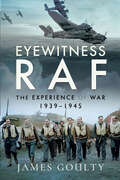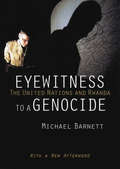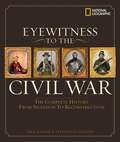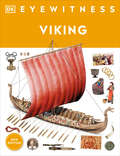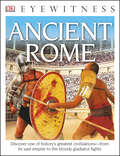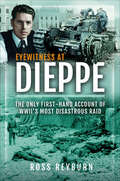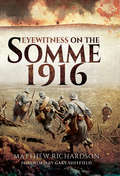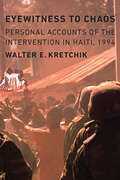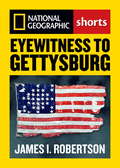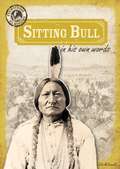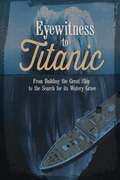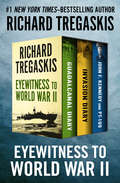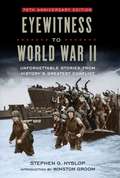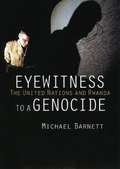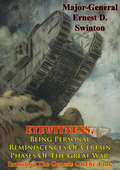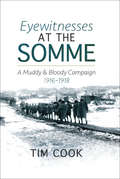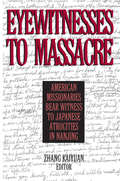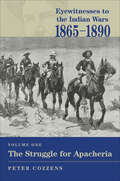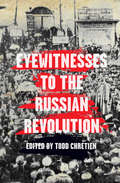- Table View
- List View
Eyewitness RAF: The Experience of War, 1939–1945
by James GoultyA detailed, realistic picture of what it was like to serve in the Royal Air Force during WWII, both on the ground and in the air, using firsthand accounts.Much has been written about the Royal Air Force during the Second World War—memoirs, biographies, histories of Fighter and Bomber commands, technical studies of the aircraft, accounts of individual operations and exploits—but few books have attempted to take the reader on a journey through basic training and active service as air or ground crew and eventual demobilization at the end of the war. That is the aim of James Goulty’s Eyewitness RAF. Using a vivid selection of testimony from men and women, he offers a direct insight into every aspect of wartime life in the service.Throughout the book the emphasis is on the individual’s experience of the RAF—the preparations for flying, flying itself, the daily routines of an air base, time on leave, and the issues of discipline, morale, and motivation. A particularly graphic section describes, in the words of the men themselves, what it felt like to go on operations and the impact of casualties—airmen who were killed, injured, or taken prisoner.What emerges is a fascinatingly varied inside view of the RAF that is perhaps less heroic and glamorous than the image created by some postwar accounts—but gives readers today a much more realistic appreciation of the whole gamut of life in the RAF seventy-plus years ago.
Eyewitness To A Genocide
by Michael BarnettWhy was the UN a bystander during the Rwandan genocide? Do its sins of omission leave it morally responsible for the hundreds of thousands of dead? Michael Barnett, who worked at the U. S. Mission to the United Nations from 1993 to 1994, covered Rwanda for much of the genocide. Based on his first-hand experiences, archival work, and interviews with many key participants, he reconstructs the history of the UN's involvement in Rwanda. In the weeks leading up to the genocide, the author documents, the UN was increasingly aware or had good reason to suspect that Rwanda was a site of crimes against humanity. Yet it failed to act. Barnett argues that its indifference was driven not by incompetence or cynicism but rather by reasoned choices cradled by moral considerations. Employing a novel approach to ethics in practice and in relationship to international organizations, Barnett offers an unsettling possibility: the UN culture recast the ethical commitments of well-intentioned individuals, arresting any duty to aid at the outset of the genocide. Barnett argues that the UN bears some moral responsibility for the genocide. Particularly disturbing is his observation that not only did the UN violate its moral responsibilities, but also that many in New York believed that they were "doing the right thing" as they did so. Barnett addresses the ways in which the Rwandan genocide raises a warning about this age of humanitarianism and concludes by asking whether it is possible to build moral institutions.
Eyewitness To The Civil War: The Complete History from Secession to Reconstruction
by Stephen G. Hyslop Neil Kagan Harris J. AndrewsAt once an informed overview for general-interest readers and a superb resource for serious buffs, this extraordinary, gloriously illustrated volume is sure to become one of the fundamental books in any Civil War library. Its features include a dramatic narrative packed with eyewitness accounts and hundreds of rare photographs, artifacts, and period illustrations. Evocative sidebars, detailed maps, and timelines add to the reference-ready quality of the text. From John Brown's raid to Reconstruction, "Eyewitness to the Civil War" presents a clear, comprehensive discussion that addresses every military, political, and social aspect of this crucial period. <p><p> In-depth descriptions of campaigns and battles in all theaters of war are accompanied by a thorough evaluation of the nonmilitary elements of the struggle between North and South. In their own words, commanders and common soldiers in both armies tell of life on the battlefield and behind the lines, while letters from wives, mothers, and sisters provide a portrait of the home front. <p> More than 375 historical photographs, portraits, and artifacts--many never before published--evoke the era's flavor; and detailed maps of terrain and troop movements make it easy to follow the strategies and tactics of Union and Confederate generals as they fought through four harsh years of war. Photoessays on topics ranging from the everyday lives of soldiers to the dramatic escapades of the cavalry lend a breathtaking you-are-there feeling, and an inclusive appendix adds even more detail to what is already a magnificently meticulous history.
Eyewitness Viking (DK Eyewitness)
by DKThis is a spectacular and informative guide to the daring adventurers of the Viking Age. Superb color photographs of Viking ships and swords, clothes and shields, memorial stones and beautiful brooches offer a unique view into the lives of the Norse people and their outstanding achievements.
Eyewitness Workbooks: Discover One Of History's Greatest Civilizations From Its Vast Empire To The Blo To The Bloody Gladiator Fights (DK Eyewitness)
by Simon James DK PublishingFrom Roman emperors and gods and goddesses to soldiers and gladiators, step into the exciting world of ancient Rome.Who were Rome's most famous emperors? What was everyday life like for a soldier in the Roman army? How did the citizens of ancient Rome live? Did gladiators really fight to the death in the mighty Colosseum? Find out the answers to all these questions, and many more, in Eyewitness: Ancient Rome.Photographs of real artifacts and detailed illustrations will help you to learn all about the time of ancient Rome, from a small city-state ruled by kings to one of the most powerful empires in history. Find out what a typical Roman house was like and what food Romans ate. Learn about how people spent their free time, whether paying a visit to the theatre, using the public bath, or watching gladiators fight a gruesome battle to the death in the world-famous Colosseum.Packed with fascinating facts, this illustrated guide is perfect for school projects or as an introduction for anyone who wants to know more about the history of ancient Rome.
Eyewitness World War I (DK Eyewitness)
by DKPacked with striking photography, Eyewitness World War I explores one of the most brutal conflicts of the 20th century.Become an eyewitness to the first conflict fought on a global scale in this picture-led reference guide that will take you on a visual tour of World War One. Made in collaboration with The Imperial War Museum, children will be mesmerized by learning about the world-changing events that led to the start of the conflict.This beautifully illustrated guide for kids aged 9+ gives an insight into life in the muddy trenches and what it was like to be a soldier, along with a broader picture of the events that took place causing the war to start. Using striking full-color photographs and illustrations of warfare, weaponry, vehicles, maps, and secret documents, this is an eyewitness view of the conflict dubbed the &“the war to end all wars&”.Throughout the pages of this newly-revised book on the First World War, you can expect to find: - A fresh new look; new photographs, updated information, and a new &“eyewitness&” feature.- Amazing facts, updated diagrams, statistics, and timelines.- Brand new eyewitness accounts from experts in the field.Eyewitness World War I introduces the ultimate guide to the first global conflict, with more than 250 photographs illustrating the people, places and stories of the war. Children can learn all about military vehicles and tank warfare, the first ever gas attacks used during a war and Armistice and peace after four years of fighting. This all-encompassing guide to World War One is a must-have for curious children aged 9+ with a thirst for learning, as well as teachers, parents and librarians.So, what&’s new? Part of DK&’s best-selling Eyewitness series, this popular title has been reinvigorated for the next generation of information-seekers and stay-at-home explorers, with a fresh new look, up to 20 percent new images, including photography and updated diagrams, updated information, and a new &“eyewitness&” feature with fascinating first-hand accounts from experts in the field.Explore the series!Globally, the Eyewitness series has sold more than 50 million copies over 30 years. Travel through the solar system with Eyewitness Space, learn the incredible systems that keep your body functioning with Eyewitness Human Body, or take a trip aboard the most famous ship in history with Eyewitness Titanic.
Eyewitness at Dieppe: The Only First-Hand Account of WWII's Most Disastrous Raid
by Ross ReyburnIn August 1942, Allied forces mounted an attack on the German-held port of Dieppe; titled Operation Jubilee, it represented a rehearsal for invasion. The amphibious attack saw over 6,000 infantrymen, predominantly Canadian, put ashore, tasked with destroying German structures and gathering intelligence. The doomed raid was an abject failure, and became Canada’s worst military disaster. Eyewitness at Dieppe is a long-overdue reissue of New Zealand-born writer Wallace Reyburn’s dramatic account of the raid. He was with the first soldiers clambering ashore, and aboard the last ship returning to England after six hours of carnage. Awarded an OBE as the only war correspondent to witness the street fighting first-hand, Reyburn was fortunate not be numbered among Dieppe’s dead, suffering just a minor wound inflicted by mortar shell fragments. His book, Rehearsal for Invasion was a wartime bestseller. Accompanied by freelance journalist Ross Reyburn’s new foreword on his father’s account, this new edition tells us more about Wallace’s intriguing life and details the shortcomings of his father’s book, dictated by wartime censorship corrected in the post-war years through a withering condemnation of raid’s mastermind Lord Mountbatten.
Eyewitness on the Somme 1916
by Matthew RichardsonWhat was the soldiers experience of the Battle of the Somme? How did the men who were there record their part in the fighting or remember it afterwards? How can we, 100 years later, gain an insight into one of the most famous and contentious - episodes of the Great War? Matthew Richardsons graphic account, which is based on the vivid personal testimony of those who took part, offers us a direct impression of the reality of the battle from the perspective of the ordinary soldiers and junior officers on the front line. He draws heavily on previously unpublished personal accounts letters, diaries, and memoirs, some never before translated into English to build up a multifaceted picture of the Somme offensive from the first disastrous day of the attack, through the subsequent operations between July and November 1916. In their own words, the soldiers who were caught up in the conflict recall in unflinching detail the fighting across the entire Somme battlefield. The narrative features the recollections of British, Commonwealth, French and American soldiers, and interweaves their testimony with descriptions left by their German adversaries. For the first time in a single volume, the reader has the opportunity to explore all facets of this momentous five-month-long struggle. Over 100 black-and-white contemporary photographs, many previously unpublished, accompany the text, whilst a selection of artifacts recovered from the battlefield is illustrated in colour. These striking objects bear silent witness to the ferocity of the battle, and often reflect some moment of personal tragedy.
Eyewitness to America: 500 Years of America in the Words of Those Who Saw it Happen
by David Colbert"The Admiral [Columbus] sailed west-southwest, at the rate of ten miles an hour and occasionally twelve, and at other times seven, running between day and night fifty-nine leagues; he told the men only forty-four. Here the crew could stand it no longer, they complained of the long voyage, but the Admiral encouraged them as best he could, giving them hopes of the profits that they might have. And he added that it was useless to murmur because he had come in search of the Indies, and was going to continue until he found them with God's help." Figures from our history come alive as we read their words and the words of those who were with them. An exciting, fascinating and easy-to-read history.
Eyewitness to Chaos: Personal Accounts of the Intervention in Haiti, 1994
by Walter E. KretchikIn September 1994 a large U.S. invasion force converged on Haiti. Years of diplomatic efforts, secret government planning, and military rehearsals on the parts of the United States and the United Nations had failed to restore to office Haiti’s democratically elected, junta-deposed president, Jean-Bertrand Aristide, and now invasion was imminent. Poised for action and mere minutes from striking, President Bill Clinton stunned military commanders when he announced a drastic change of plan: a peaceful cooperation with an illegal government. In Eyewitness to Chaos Walter E. Kretchik retells the experience of this unprecedented and convoluted operation through the voices of its participants. Synthesizing accounts from a cross section of military officials, Kretchik unveils the little-known inner workings of government and military planning and the real-world quandaries of operational execution faced by those involved. The thirty-seven interviewees provide insight into the many facets of the operation: strategic and operational planning; intelligence gathering; multinational force design; medical and legal complications; communication concerns; contracting and logistics; ethnic, cultural, and historical considerations; mission execution; and language barriers. What emerges is a new perspective on this attempt to secure a brighter future for Haiti’s people.
Eyewitness to Gettysburg
by Stephen G. HyslopAuthor James Robertson, one of America's most respected Civil War scholars and storytellers whose weekly talks about little-known people and events of the Civil War aired for 15 years on National Public Radio, brings history to life here in a collection of unexpected and true stories revealing the events that took place as great events unfolded. He explores such gripping subjects as the post-battle horrors of the wounded, the destruction of Robert E. Lee's aura of invincibility, and the invention of a new way to remove the wounded from the battlefield. In addition, an introductory overview of the Civil War traces the major events of the conflict year by year. Painstakingly researched and deeply personal, this ebook offers a unique reading experience for the millions of Civil War buffs and all those interested in the previously untold stories behind this great chapter in America's past.
Eyewitness to Gettysburg
by Stephen G. HyslopJames Robertson, one of America's most respected Civil War scholars and storytellers whose weekly talks about little-known people and events of the Civil War aired for 15 years on National Public Radio, brings history to life here in a collection of unexpected and true stories revealing the events that took place as great events unfolded. He explores such gripping subjects as the post-battle horrors of the wounded, the destruction of Robert E. Lee's aura of invincibility, and the invention of a new way to remove the wounded from the battlefield. In addition, an introductory overview of the Civil War traces the major events of the conflict year by year. Painstakingly researched and deeply personal, this ebook offers a unique reading experience for the millions of Civil War buffs and all those interested in the previously untold stories behind this great chapter in America's past.
Eyewitness to History: Sitting Bull in His Own Words
by Julia McdonnellSitting Bull, the well-known Native American chief, united the Lakota Sioux in the northern Great Plains and led a mighty resistance of tribes who refused to be placed on reservations. This struggle resulted in violence, most famously at Little Bighorn in 1876. Though Sitting Bull fled to Canada, he ultimately returned to the United States in 1881. This book uses Sitting Bull's powerful words to examine the leader's considerable courage and determination as well as his aspirations for Native Americans.
Eyewitness to Power: The Essence of Leadership Nixon to Clinton
by David GergenFrom Nixon to Clinton, Watergate to Whitewater, few Americans have observed the ups and downs of presidential leadership more closely over the past thirty years than David Gergen. A White House adviser to four presidents, both Republican and Democrat, he offers a vivid, behind-the-scenes account of their struggles to exer- cise power and draws from them key lessons for leaders of the future. Gergen begins Eyewitness to Power with his reminiscence of being the thirty-year-old chief of the White House speechwriting team under Richard Nixon, a young man at the center of the Watergate storm. He analyzes what made Nixon strong-and then brought him crashing down: Why Nixon was the best global strategist among recent presidents. How others may gain his strategic sense. How Nixon allowed his presidency to spin out of control. Why the demons within destroyed him. What lessons there are in Nixon's disaster. Gergen recounts how President Ford recruited him to help shore up his White House as special counsel. Here Gergen considers: Why Ford is one of our most underrated presidents. Why his pardon of Nixon was right on the merits but was so mishandled that it cost him his presidency. Even in his brief tenure, Ford offers lessons of leadership for others, as Gergen explains. Though Gergen had worked in two campaigns against him, Ronald Reagan called him back to the White House again, where he served as the Gipper's first director of communications. Here he describes: How Reagan succeeded where others have failed. Why his temperament was more important than his intelligence. How he mastered relations with Congress and the press. The secrets of "the Great Communicator" and why his speeches were the most effective since those of John Kennedy and Franklin Roosevelt.
Eyewitness to Titanic: From Building the Great Ship to the Search for Its Watery Grave
by Terri Dougherty Sean Stewart Price Sean McCollumView the story of the doomed ship Titanic through the eyes of those who knew it best. Builders, crew members, passengers, and explorers who discovered the wreck each have their own perspectives. Feel the pride of builders as they put the final touches on the grand staircase and the deep sadness of survivors who left loved ones behind. It's the story of the Titanic like you've never heard it before.
Eyewitness to World War II: Guadalcanal Diary, Invasion Diary, and John F. Kennedy and PT-109
by Richard TregaskisThree classic accounts of WWII from a reporter who &“shaped America&’s understanding of the war, and influenced every account that came after&” (Mark Bowden). Volunteer combat correspondent Richard Tregaskis risked life and limb to give American readers a soldier&’s–eye view of the Second World War. These three tales of bravery and sacrifice shed light on the Greatest Generation&’s darkest hours. Guadalcanal Diary: In August 1942, Tregaskis landed with the US Marines on Tulagi and Guadalcanal Islands in the South Pacific for the first major Allied offensive against Japanese forces. He details the first two months of the campaign and describes the courage and camaraderie of young marines who prepared for battle knowing that one in four of them wouldn&’t make it home. An instant #1 New York Times bestseller and the basis for a popular film of the same name, Guadalcanal Diary is a masterpiece of war journalism that &“captures the spirit of men in battle&” (John Toland). Invasion Diary: In July 1943, Tregaskis joined the Allied forces in Sicily and Italy and documented some of the fiercest fighting of the war, from bombing runs over Rome to the defense of the Salerno beachhead against heavy artillery fire to the fall of Naples. In compelling and evocative prose, Tregaskis depicts the terror and excitement of life on the front lines and his own harrowing brush with death when a chunk of German shrapnel pierced his helmet and shattered his skull. Invasion Diary is &“required reading for all who want to know how armies fight&” (Library Journal). John F. Kennedy and PT-109: In the early morning hours of August 2, 1943, the Japanese destroyer Amagiri sliced into US Navy motor torpedo boat PT-109 near the Solomon Islands. Ten surviving crewmembers and their young skipper, Lt. John F. Kennedy, clung to the wreckage. Over the next three days, the privileged son of a Boston multimillionaire displayed extraordinary courage and leadership as he risked his life to shepherd his crew to safety and coordinate a daring rescue mission deep in enemy territory. Lieutenant Kennedy earned a Navy and Marine Corps Medal and a Purple Heart, and the story of PT-109 captured the public&’s imagination and helped propel Kennedy all the way to the White House. Acclaimed war correspondent Tregaskis—who once beat out the future president for a spot on the Harvard University swim team—brings this remarkable chapter in American history to vivid life.
Eyewitness to World War II: Unforgettable Stories From History's Greatest Conflict
by Winston Groom Stephen G. HyslopThis elegant narrative edition of Neil Kagan's best-selling Eyewitness to World War II offers incredible first-person stories and amazing moments of heroism, providing new context and perspective on history's greatest conflict. The unforgettable story of World War II is told through the words of those who lived it--both on the battlefield and the home front--creating a dramatic tapestry of the wartime experience. Personal writings and recollections of Roosevelt, Hitler, and Patton, as well as letters composed by soldiers at battle and diaries of women serving in the military at home, present an absorbing narrative that tells the entire history of the war from several perspectives. In this absorbing reader's edition, a carefully curated selection of memorable, significant photographs and illuminating maps from the 2012 book accompanies the revised text. Comprehensive and compelling, this finely wrought book is as gift-worthy as its predecessor.
Eyewitness to a Genocide: The United Nations and Rwanda
by Michael BarnettVery little about the Rwandan genocide is comprehensible. A Hutu elite came to believe that Hutu salvation necessitated Tutsi extermination. The Hutus enacted their conspiracy with startling efficiency. In one hundred days, between April 6 and July 19, 1994, they murdered roughly eight hundred thousand individuals. For the statistically inclined, that works out to 333&1/3 deaths per hour, 5&1/2 deaths per minute. The rate of murder was even greater during the first four weeks, when most of the deaths occurred. The Rwandan genocide, therefore, has the macabre distinction of exceeding the rate of killing attained during the Holocaust.
Eyewitness to the Peninsular War and the Battle of Waterloo: The Letters and Journals of Lieutenant Colonel James Stanhope 1803 to 1825 Recording His Service with Sir John Moore, Sir Thomas Graham and the Duke of Wellington
by Gareth GloverThe journals of the Honourable James Stanhope are among the most remarkable eyewitness accounts of the Peninsular War and the Battle of Waterloo, and yet they have never been published before. The long fight against the French in Portugal and Spain, the campaign in Holland, then the Battle of Waterloo James Stanhope lived through all these extraordinary events and recorded them in vivid detail.Stanhope served as an aide de camp to the major commanders of the day Wellington, General Graham, Lord Paget, the Duke of York among them. And he described his experiences and observations in a lucid and candid prose that makes his journals of great historical value and of compelling interest to us today. His writing gives a graphic inside view of the military and political situation of the time as it was perceived at the top levels of the British army, and he depicts the daily experience of campaigning during the Napoleonic Wars in an unforgettable way.
Eyewitness, Being Personal Reminiscences Of Certain Phases Of The Great War,: Including The Genesis Of The Tank [Illustrated Edition]
by Major-General Ernest D. SwintonIncludes the First World War Illustrations Pack - 73 battle plans and diagrams and 198 photosMajor-General Ernest Swinton had already had a long and illustrious career in the British Army before the advent of the First World War in 1914. Appointed as the official war correspondent by the war Minister Lord Kitchener in 1914, his reporting home was the only way for the British people to follow the war as journalists were at that time banned at the front. In these dispatches from the front Swinton told the public of the bloody fighting in Flanders and the heroic efforts of the Allies to stop the German Juggernaut. The miserable conditions and bloody siege warfare of the trenches left a lasting impression on him and he looked to a scientific solution to the muddy stalemate of the Western Front. He would gain lasting fame as the architect of the "tank" project that was to revolutionize warfare in the First World War and for many years thereafter. In this volume of reminiscences he traces his involvement in the early years of the war and his later years as the driving force in the development and adoption of the tank.
Eyewitness: Spy
by Richard PlattThe most trusted nonfiction series on the market, Eyewitness Books provide an in-depth, comprehensive look at their subjects with a unique integration of words and pictures.
Eyewitnesses at the Somme: A Muddy and Bloody Campaign, 1916–1918
by Tim CookIn 1915, news of the Australian and New Zealand Army Corps landing and the slaughter at Gallipoli stirred tens of thousands of young men to go to war.They answered the call and formed battalions of the Australian Imperial Force. By the time the new recruits were combat ready, the campaign at Gallipoli had ended. Their battlefields became the muddy paddocks of France and Belgium.Based on eyewitness account, Eyewitnesses at the Somme traces the story of one of these battalions, the 55th, from its birth in the dusty camps of Egypt through three years of brutal, bloody conflict on the bitter western front.When the Great War ended in 1918, over 500 of the 3,000 men who served in the 55th had been slain and another 1,000 wounded. Eyewitnesses at the Somme, shares personal stories of Australian men as they stared down the horrors of war with determination, courage and comradeship. With chapters devoted to the significant battles at Fromelles, Doignies, Polygon Wood, Pronne and Bellicourt, this book tells the story of one battalion, but in doing so it encapsulates the experiences of many Australians on the Western Front.
Eyewitnesses to Massacre: American Missionaries Bear Witness to Japanese Atrocities in Nanjing
by Zhang Kaiyuan Donald MacInnisThe infamous Nanjing Massacre of 1937, in which the Japanese Imperial Army raped and slaughtered countless Chinese citizens on the eve of World War II, has been described in well-publicized books from various Chinese, Japanese and German perspectives. But this collection of first-hand testimony from the archives of the Yale Divinit; School Library may be the most powerful record of all. Here are eyewitness accounts by a remarkable group of nine men and one woman - dedicated, compassionate, well-educated, articulate, and devout missionaries who were ther on the scene, refusing to leave, and doing everything in their power to save the Chinese victims of this appalling atrocity.
Eyewitnesses to the Indian Wars, 1865–1890: The Struggle for Apacheria
by Peter CozzensThis volume explores the history of the Apache Wars of the late 19th century Southwest through diaries, army reports, and other primary sources. Stretching from the Colorado River to the mountains east of the Rio Grande, and from northern Arizona into Sonora, Mexico, is the sprawling region once known as Apacheria. By the time the first Americans ventured into the region, the indigenous peoples known as the Apache had already been clashing with Spanish and Mexican interlopers for some time. Eyewitnesses to the Indian Wars, 1865–1890: The Struggle for Apacheria presents a selection of outstanding original accounts pertaining to the epic struggle between American and the Apache for those coveted lands. It is the first in a five-volume series telling the saga of the military struggle for the American West in the words of the soldiers, noncombatants, and Native Americans who shaped it
Eyewitnesses to the Russian Revolution
by Todd ChretienThis comprehensive chronicle of the Russian Revolution is told through the eyewitness accounts of journalists, political leaders, and ordinary citizens.More than a century ago, workers and peasants in Russia turned the world upside down when they overthrew their tsar, took over their factories, farms, and schools, and set out to build a new society. In this gripping reader, participants and firsthand observers of the revolution tell the inspiring, heroic, and sometimes tragic story of what happened in Russia over the course of 1917. Introduced and edited by Todd Chretien, Eyewitnesses to the Russian Revolution includes contributions from Leon Trotsky, Rosa Luxemburg, Vladimir Lenin, John Reed, Louise Bryant, and others.
